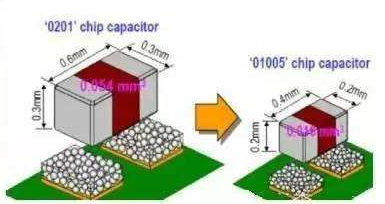With the development trend of the miniaturization of SMD components and the higher and higher requirements of the SMT process, the electronic manufacturing industry has higher and higher requirements for testing equipment. In the future, SMT production workshops should have more testing equipment than SMT production equipment. The final solution should be a combination of SPI + AOI before the furnace + AOI + AXI after the furnace.
- The trend of miniaturization of SMD components and the demand for AOI equipment
With the progress of society and the development of science and technology, more and more portable devices meet people’s various wishes, and the production is more and more sophisticated, such as Bluetooth headsets, PDAs, netbooks, MP4, SD cards and so on. The demand for these products has stimulated the development of the miniaturization of SMD components, and the miniaturization of components has also promoted the development of portable devices. The development trend of SMD passive components is like this: 0603 components appeared in 1983, 0402 components appeared in 1989, 0201 components began to appear in 1999, and today we have begun to use 01005 components.
01005 components were initially used in size-sensitive and cost-insensitive medical equipment such as pacemakers. With the large-scale production of 01005 components, the price of 01005 components has dropped by 5 times compared to the price when it was first launched, so the use of 01005 components With the reduction of cost, the scope is continuously expanded to products in other fields, thereby stimulating the continuous emergence of new products.
SMD components have evolved from 0402, to 0201 and then to 01005. The size changes are shown in the figure below:
The size of 01005 chip resistor is 0.4 mm×0.2 mm×0.2 mm, the area is only 16% and 44% of the former two, and the volume is only 6% and 30% of the former two. For size-sensitive products, the popularity of 01005 brings life to the product. Of course, it also brings new challenges and opportunities to the electronics manufacturing industry! The production of 01005 components and 0201 components places extremely high precision requirements on SMT production equipment from front to back.
For 0402 components, visual inspection is already very laborious and difficult to last, let alone the popularized 0201 components and the developing 01005 components. Therefore, it is an industry consensus that SMT production lines need AOI equipment for inspection. For components such as 0201, if a defect occurs, it can only be placed under the microscope and repaired with special tools. Therefore, the maintenance cost has become much higher than that of the 0402. For components of 01005 size (0.4×0.2×0.13mm), it is difficult to see with the naked eye alone, and it is even more difficult to operate and maintain with any tool. Therefore, if the 01005 component has defects in the process, it can hardly be repaired. Therefore, with the development of miniaturization of devices, we need more AOI machines to control the process, not only to detect defective products. In this way, we can find defects in the process as early as possible, improve the process, and reduce the occurrence of errors.
- In this way, we can find defects in the process as early as possible, improve the process, and reduce the occurrence of errors.
Although AOI equipment originated 20 years ago, for a long period of time, it was expensive and difficult to grasp, and the detection results were not satisfactory. AOI only existed as a concept and was not recognized by the market. However, since 2005, AOI has developed rapidly. AOI equipment suppliers have sprung up. Various new concepts and new products have emerged one after another. In particular, domestic AOI equipment manufacturers are the pride of China’s SMT industry, and domestic AOI equipment is in use. In effect, it is no longer up and down with foreign products, and because of the rise of domestic AOI, the overall price of AOI has dropped to 1/2 to 1/3 of the previous. Therefore, in terms of the labor cost saved by AOI instead of manual visual inspection, buying AOI is also It is worthwhile, not to mention that using AOI can also increase the straight-through rate of the product and obtain a more stable detection effect than manual. So AOI is already a necessary equipment for the current SMT processing manufacturers.
Under normal circumstances, AOI can be placed in 3 positions in the SMT production process, after printing the solder paste, before reflow soldering and after reflow soldering to monitor the quality of different sections. Although the use of AOI has become a trend, most manufacturers still only install AOI behind the furnace, and use AOI as the last gatekeeper for the product to flow into the next section, only instead of manual visual inspection. In addition, many manufacturers still have misunderstandings about AOI. No AOI can achieve no false test, and no AOI can achieve no missed test. Most AOIs choose the right balance between false test and missed test, because the algorithm of AOI is either way. Compare the current sample with the computer sample (either an image or a parameter), and make a judgment based on the similarity.
At present, there are still many dead corners in the AOI after the furnace is used. For example, the single-lens AOI can only detect part of QFP, SOP, and false welding. However, the detection rate of multi-lens AOI for QFP and SOP’s lifted feet and less tin is only 30% higher than that of single-lens AOI, but it increases the cost of AOI and the complexity of operating programming. These images are produced using visible light. AOI is powerless to detect invisible solder joints such as BGA missing balls and PLCC false soldering.
Post time: Aug-19-2020

